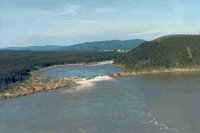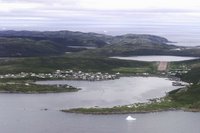The
 Torngat Mountain range is already a national park reserve. The whole of Labrador is a hiker's paradise, photographer's heaven, an adventurer's playground, and an alluring scenery buffet.
Torngat Mountain range is already a national park reserve. The whole of Labrador is a hiker's paradise, photographer's heaven, an adventurer's playground, and an alluring scenery buffet.It is good to know that the transportation system across Labrador is being constructed, but there are delays. Originally the basic construction was set to be completed by 2008. That's been put back to 2009.
 (source: NL Gov., Dept. of Works, Services & Transportation)
(source: NL Gov., Dept. of Works, Services & Transportation)The completion of the TLH is a priority, a top tourism priority, and a vital infrastructure link for residents who rely on the highway to travel for basic needs, not to mention more serious matters concerning health. We all know that a difference in minutes and seconds can be the difference between life and death, but imagine suffering a heart attack and having to drive extra travel hours to get to a medical facility. A paved road would save hours on certain drives, as well as lives. Phase I and II are mostly gravel road, and phase III is still under construction and will resume in the spring.
There is every advantage to a more speedy highway completion with asphalt surface. There are many reasons to accelerate the development of the road system. As mentioned, for residents' use alone. For all intents and purposes the island of Newfoundland has a very accomodating highway and road system. There are some places on the south coast that still rely on the coastal boat service to provide supplies and transportaion. We as islanders take this for granted. Many residents and parts of Labrador can not take the transportation system for granted. They are not on par with the rest of us on the island of Newfoundland.
A full hard top road system will open up more opportunities for economic development. For those with an entrepreneurial inclination an inviting paved TLH must be great news, and help in the business development mindset. Possibly there could be more service stations, convenience stores, Tim Horton's?, camp grounds, parks, hiking outposts, canoeing/kayaking businesses, fishing or hunting trips, outback expedition businesses, snowmobile rentals, flight rentals, skiing or golf resorts, cabin development, forestry and mining industries, and others. The easier it is to get to places like this, the more likely people will come, the more likely more people than at present will come, and perhaps more likely people will come more often.
It must be frustrating to have to travel long distances on gravel roads. Before the Burin Peninsula and the TCH were paved it would take up to 10 hours to travel from my old home town to St. John's. Now it can be done in 3-3.5 hours. For car owners it is doubly irritating when you suffer the many car problems arising from such a long rock popping drive. The incidence of broken windshields, tire damage, base pan damage, paint chipping, and other problems are multiplied when travelling on dirt roads. If tourists did not have to experience such problems, they would probably be happier campers, which leads me to the tourism aspect of the TLH.
There are beautiful places in the province that are never seen by most of the public because they were not advertised or publicized. I have done searches on the web and have seen interesting and beautiful places from Labrador, but there are others I cannot find. There are some scenic places like
 Porcupine Strand, a 40 km stretch on Labrador's coast
Porcupine Strand, a 40 km stretch on Labrador's coastOur tourism agencies could broaden their scope in terms of presenting more places to visit. With a fully completed TLH, they will be able to promote places in such a way as, "Just a one hour drive from Goose Bay, Glacial valleys at Grand River and Grand Lake can be seen along the Trans Labrador Highway", or "The Wilson River area is especially picturesque in the fall, and the Bowdoin Canyon and Muskrat Falls

are also short strolls from the road. The Mealy Mountain range is near the TLH."
There are many beautiful places in the whole province that don't get the exposure it deserves simply for aesthetics sake alone. On the coast there are some nice looking communities like St. Lewis

When I see an image of some beach, coastline, rock formation, cove, hilltop view, that I haven't seen before, it makes me proud to be a citizen of NL, just to know that this is where I live - and look what we have all around us. I then wonder why places like Porcupine Strand in Labrador, Grand River, etc. are not presented when our tourism brochures are produced. Instead of more of the same, Cape Spear, Quidi Vidi, a typical lighthouse, it would be refreshing to see other places in the province used in tourism brochures.
While much of Labrador is 100's of miles from the nearest road, it is still popular with hikers, adventure tourists, mountain climbers and photographers. This is especially true for the Torngat Mountains, Cirque Mountains, Palmer River Valley. There are a outfitting and tour companies ready to take you to those places. But the potential growth in this sector alone seems like the big land sky's the limit. It would be much more enticing for people to want to see Labrador when there is a smooth, paved, and speedier road infrastructure. It's alot more to look forward to when you know a trip won't take two or three times as long as by gravel road. For anyone curious about what the landscape looks like, who wants to take new photographs, who wants to appreciate and enjoy clean sprawlig, rolling and rugged landscapes, then the paved TLH will be like just landing on a new planet, and that discovery is exciting.
How can the completion of the TLH be sped up when the Labrador Transportation Initiative Fund, LTIF, is run dry? With time the TLH will likely help increase business for current entrepreneurs, or help ignite new business initiatives. For the province this means more tax income in the future. I'm not an economist but it seems the NL government can reserve say for example, an extra $50 million (beyond any budgeted amount), roughly enough to cover an additional 50 km worth of paved highway, from the next surplus the province gets. Federal funds to match or even double this amount will speed up the process.
Mile 1 Club
The west coast of Canada obviously has by far the highest, and many would think the most spectacular mountain ranges. Most provinces east of Alberta have low elevaton hills in comparison. However, Labrador's mountains bring it into the mile 1 club. There are at least two mountains that are actually more than a mile high. They are situated in the Torngat Mountain range in northern Labrador. Mount Caubvick's elevation is 5420 feet. Mont D'Iberville is 5419 feet, and virtually a mile high is Torngarsoak Mountain at 5232 feet.
Here is a great picture of another virtual "miler", Mount Erhart (elevation, 5049 ft.).

I will be sending a letter to Hospitality Newfoundland & Labrador in support of expediting the TLH completion, and improve the ferry service (more on this later) to Labrador. It will be posted here for anyone else to copy it if interested.

1 comment:
Note: Due to problems with updating on blogroll, I republished this blog, but here is a comment from WJM which was posted first.
WJM
How can the completion of the TLH be sped up when the Labrador Transportation Initiative Fund, LTIF, is run dry?
By putting money into Labrador from the same Consolidated Revenue Fund that Labrador taxes and other revenues contribute to in the first place, that's how.
Post a Comment